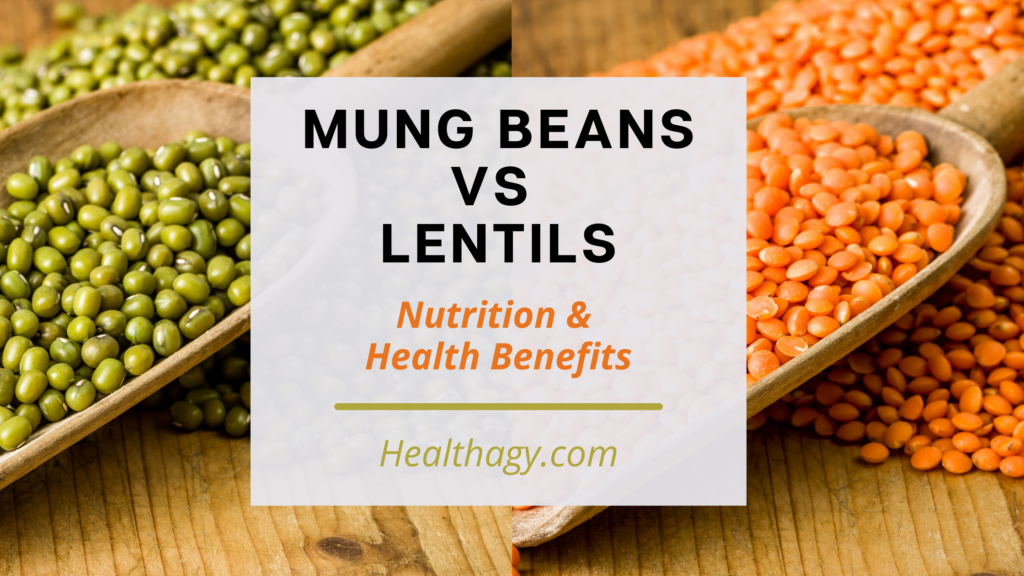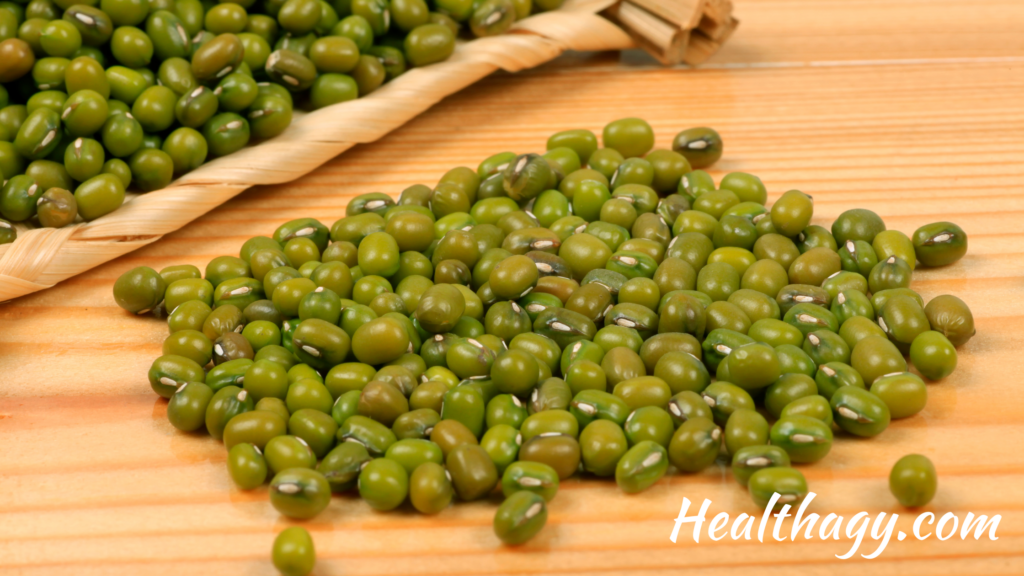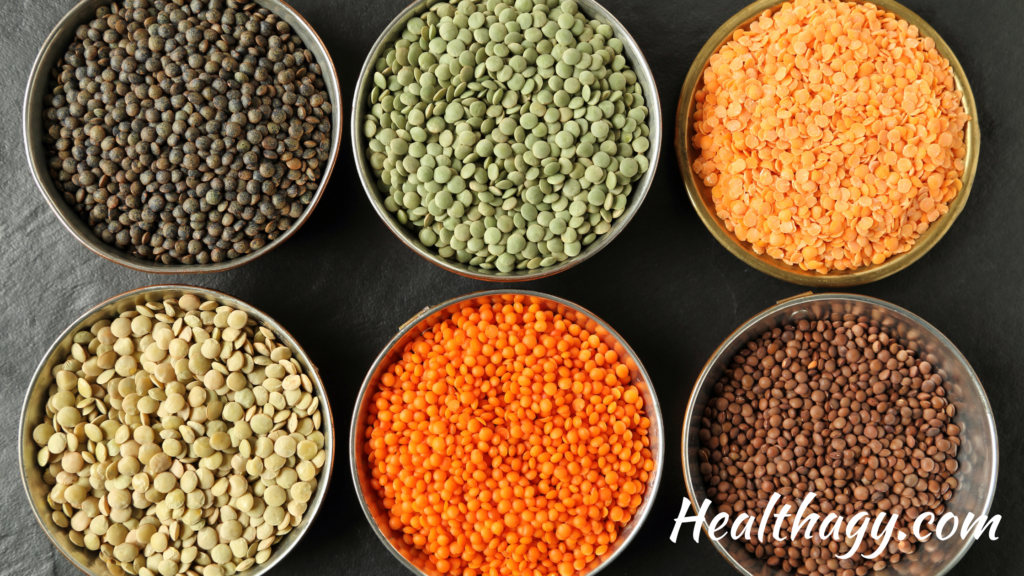
Key Differences Mung Beans vs Lentils
Mung beans and lentils are very similar as they are both pulses, which are edible seeds. They are part of the legume and pea families, although neither are peas.
The main differences between the two are in their nutritional values. Lentils have slightly more calories, protein, and dietary fiber. A one-cup serving size of cooked mung beans contains 212 calories compared to 230 calories for one cup of cooked lentils. Mung beans contain 14.2 grams of protein, and lentils 17.9 grams of protein. Mung beans contain 15.4 grams of dietary fiber, and lentils 15.6 grams.

What are Mung Beans?
Mung beans, like lentils, are both types of legumes and part of the Fabaceae or Leguminosae family, more commonly known as the pea family. Mung beans have been around since ancient times. They are also known as green gram, maash, monggo, and munggo.
They are tiny green beans and a type of pulse, which are edible seeds from a legume plant.
Mung beans are native to India but can not be found in foods throughout the world, most commonly in some Asian and Indian cooking.
While they aren’t very popular in the United States, where popular beans such as pinto beans, black beans, kidney beans, and great northern beans are still dominating. Mung beans have been gaining attention from people health-focused or interested in more cultural foods and healing foods and can be found in healthy food stores. They can also be used in protein powders and canned soups.
Mung Beans Taste
Whole mung beans, with the skins on, have a slightly sweet, nutty flavor similar to green leafy vegetables. Mung beans are also skinned and split, which is called mung dal or moong dal.
The mung dal is what is found inside a whole mung bean. When the skin is removed, mung dal is tiny and yellow with a mild sweet flavor. Yellow mung beans are often used in desserts and in making khichdi. They can also be ground into flour to make cellophane noodles in Chinese cuisine.
Mung Beans Uses
Mung beans are sold in three different forms, mung bean sprouts, fresh beans, or dried beans. They come in whole form, as a whole mung bean or a split mung bean, which looks just like a lentil. They are versatile beans, commonly eaten in soups, added to salads and sandwiches (particularly the sprouted version), and added into stir-frys.
Sprouted beans have a slightly different nutritional composition from their fresh and dried counterparts. They contain more amino acids and antioxidants and fewer calories. Soaking beans and allowing them to sprout is a common practice that helps reduce phytic acid levels, an antinutrient that can interfere with the absorption of some minerals like zinc, magnesium, and calcium.

What are Lentils?
Lentils, like mung beans, are also legumes and part of the Fabaceae or Leguminosae family, also known as the pea family. Lentils are also an ancient food that dates back thousands of years.
Lentils are also known as a “pulse” and are considered nutritionally to act like a grain, while they are not technically a grain.
Lentils Taste
Lentils come in a variety of colors and have a somewhat distinct taste and use in foods depending on their type.
Types of Lentils
Black lentils are tiny and jet-black; they have the most earthy flavor of the lentils. They pair well with vegetables, mushrooms, and meat dishes.
Ivory white lentils are black lentils that have been hulled, meaning their skin has been removed. They also come as split lentils.
Brown lentils have a more mild and earthy flavor than black lentils. They are also not as flat as other lentils, more sphere-shaped. They make a great veggie burger base as their texture holds up well when cooked. They are a common and popular variety found in plant-based foods.
French lentils are either grown domestically in the United States or imported from France. They are smaller than brown or green lentils, with a deep green color. They have a slight peppery flavor to them and can typically be found in more gourmet-type food stores.
Green lentils are the most common type of lentil you’ll find at the grocery store. They tend to be brownish-beige in color but are called “green lentils” but may also be referred to as brown lentils. They have a nutty taste and mix well with salads while making a great side dish.
Red lentils and yellow lentils have a sweet flavor. You will find them most commonly in Middle Eastern and Indian cuisine. They tend to cook fast and don’t have much texture once cooked, which makes them great to add to pureed soups, and sauces or as an addition to the main dish for flavoring. They may come hulled or unhulled.
Mung Beans vs Lentils Nutritional Profile
Below are the key nutritional values of one cup of lentils (cooked) and one cup of mung beans (cooked).
| 1 cup of Mung Beans (cooked), about 202 grams % Daily Value | 1 cup of Lentils (cooked), about 198 grams % Daily Value | |
| Calories | 212 | 230 |
| Total Carbohydrate -Dietary fiber -Sugar – Added Sugars | 38.7 g, 13% 15.4 g, 55% 4 g, 8% 0 g | 39.9g, 13% 15.6 g, 56% 3.6 g, 7% 0 g |
| Protein | 14.2 g, 28% | 17.9 g, 36% |
| Total Fat Saturated Fat | 0.8 g, 1% 0.2 g, 1% | 0.8 g, 1% 0.1 g, 1% |
| Vitamin D | 0 mcg | 0 mcg |
| Calcium | 54.5 mg, 4% | 37.6mg, 3% |
| Iron | 2.8 mg, 16% | 6.6 mg, 37% |
| Potassium | 537.3 mg, 11% | 730.6 mg, 16% |
| Phosphorus | 200 mg, 16% | 356.4mg, 29% |
| Magnesium | 97mg, 23% | 71.3mg, 17% |
| Zinc | 1.7 mg, 15% | 2.5mg, 23% |
| Vitamin C | 2 mg, 2% | 3 mg, 3% |
| Vitamin E | 0.3 mg, 2% | 0.2mg, 1% |
| Manganese | 0.6 mg, 26% | 1mg, 43% |
| Selenium | 5.1 μg, 9% | 5.5μg, 10% |
| Thiamin (Vitamin B1) | 0.3 mg, 28% | 0.3mg, 28% |
| Riboflavin (Vitamin B2) | 0.1 mg, 9% | 0.1mg, 11% |
| Niacin (B3) | 1.2 mg, 7% | 2.1mg, 13% |
| Vitamin B6 | 0.1 mg, 8% | 0.4mg, 21% |
| Folate (B9) | 321.2 μg, 80% | 358.4μg, 90% |
While mung beans and lentils vary in their nutrient values, they have similar nutrient profiles, containing a wide variety of vitamins and minerals. They are both a good source of protein, with lentils having slightly more protein content at 17.9 grams per serving compared with 14.2 grams for mung beans. As a plant-based protein, they are both low on the essential amino acid methionine, making them an incomplete source of protein.
However, soaking and sprouting lentils and mung beans for about 8-14 hours before cooking changes their nutritional components and may increase the essential amino acids to make a complete protein. Although the best way to make sure you are getting all nine essential amino acids is to eat a variety of whole grains such as rice or quinoa along with lentils or beans throughout the day.
Nutrition & Health Benefits Mung Beans and Lentils
Both mung beans and lentils are heart-healthy legumes, which are a good source of magnesium and folate. They are both a great source of protein, dietary fiber, and several other key vitamins and minerals such as iron, phosphorous, manganese, several B vitamins, pantothenic acid, potassium, selenium, and zinc.
Good Sources of Antioxidants
They are both rich in polyphenols, a type of health-promoting phytochemicals with antioxidant abilities that help neutralize free radicals. Antioxidants help fight off signs of aging and have anti-inflammatory properties, which may also help reduce chronic inflammation.
Cholestrol Level
They have also been shown to have properties that can help lower LDL cholesterol., which can also help lower your risk of heart disease.
Blood Pressure
Lentils and mung beans may also help lower blood pressure as they are good sources of potassium, fiber, and magnesium, which all have been shown to help lower the risk of high blood pressure. Reducing high blood pressure also helps reduce your risk of heart disease.
Digestive Health
Both are excellent sources of dietary fiber, and the other vitamins and minerals they contain all help support a healthy gut.
Pregnancy
Folate-rich foods, such as mung beans and lentils, are essential for a baby’s healthy growth. It is advised that pregnant women should avoid eating raw mung bean sprouts as they carry of risk of having bacteria that could cause an infection. Pregnant women should opt for cooked sprouts to be safe.
Key Takeaways
Mung beans and lentils are both great options for a plant-based diet. They have many similarities, with minimal nutritional differences overall. It really comes down to a personal preference in deciding which is a healthier choice for you!
Karla Kueber is a Certified Evidence Based EFT Practioner and Health Coach, with a double Masters Degree in Education. She works with people to overcome emotional eating, curb cravings, and overcome resistance to eating new healthy foods. You can learn more about coaching with her here.